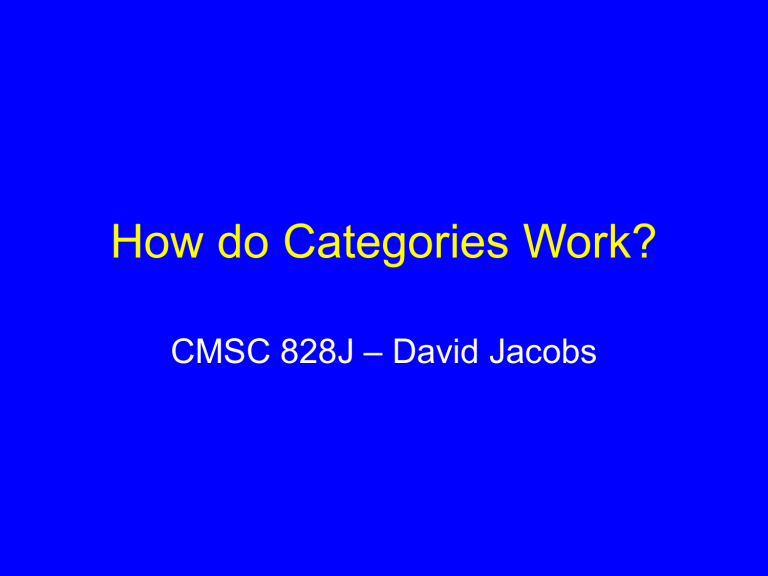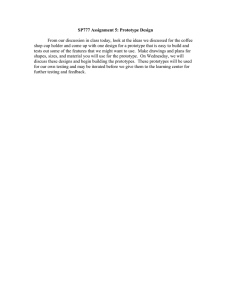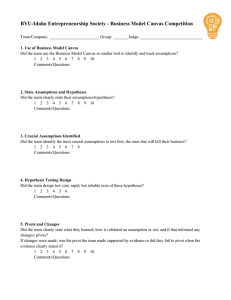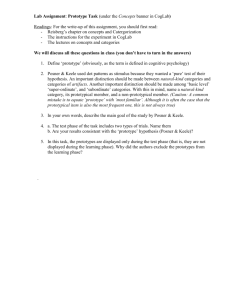Paper Presentation:

How do Categories Work?
CMSC 828J – David Jacobs
Basic Questions
• What is a category? ( class, concept )
– A set of objects/things? What sets are valid?
– A probability distribution?
• What determines what belongs to a category?
– With a category comes the ability to judge in principle whether new things are part of it. How does this work?
– Are categories in the world or in our head?
• How do we determine categories computationally?
– How do we represent and use prior knowledge?
– How do we cope with partial information? ….
Visual Categories
• Papers don’t talk much about specifically visual, but we want to consider this.
• Only some categories do we expect to perceive visually.
– Yes: Red.
• This is nothing but visual.
– Probably yes: Chair, desk, maple.
• Structure is important to what they are.
– Maybe: Measles.
• Vision is diagnostic, but not integral to what it is.
– Very tough: game, convince.
Visual Categories
• We don’t ask: “Is this a chair?”, we ask:
“Does this look like a chair?”
• Viewing conditions (eg., pose, lighting) affect an object’s appearance.
The Papers
• Women, Fire and Dangerous Things by
Lakoff, Chapters 1 and 2.
• S. Laurence and E. Margolis,
``Concepts and Cognitive Science'', in
Concepts edited by E. Margolis and S.
Laurence, MIT Press.
• L. Wittgenstein, Philosophical
Investigations, sections 65-78.
Outline
• Focus on two theories of categories, classical and prototype.
• Then, Dual Theory.
• Basic level categories.
We’ll focus first on:
• Classical theory – a category is definable.
– Certain properties are present or absent.
Example: a chair has a seat. A briefcase has a handle.
– Eventually, these bottom-out in something verifiable by senses.
– Category membership is binary.
– Intuitive: we think things have definitions.
– Held with little question for ~2,000 years.
– Initial focus of AI, cognitive science: eg., Schank,
Hayes, expert systems, anthropology.
• Prototype theory
– Not really a theory, ie., not too specific.
– States that categories have structure. Prototypes.
– Example of a specific prototype theory: a statistical model based on properties.
• Gaussian distribution;
• weighted combination of properties: eg., Bird Properties: flies, sings, lays eggs, is small, nests in trees, eats insects. All are true of a robin, but maybe only some need to be true (eg., a chicken).
– Wittgenstein: Family resemblance, rope.
Representational power? (Plato’s problem).
• Precise definitions are actually quite difficult.
– Wittgenstein’s example game started this. “Don’t think but look”.
– Knowledge as justified true belief.
• The story of the tennis match.
– Paint
• X covers Y with paint (exploding paint factory).
• Plus x is an agent (I kick over paint bucket).
• It’s intentional. (Michaelangelo painting mural).
• Intention is to cover with paint (dip brush in paint).
– This might be an issue of representational power, or just that definitions are hard to uncover.
Representational power?
– Are there visual analogs to these?
• Visual categories may be simpler(?)
• But definitions in terms of visual properties are harder.
– Even if I can define a chair as something one person can sit in, this is far from a visual definition. Classical theory assumes ultimately there’s a visual definition, but doesn’t usually try to work it all out.
– Even very simple visual properties are hard. Try to define “gray”.
Representational power?
• Prototype theory
– In its vaguest form, has arbitrary power.
– In simpler form, more powerful than definitions, but is it powerful enough?
– But still faces problem of feature selection, and reducing these to sensory inputs.
Prototype Structure of Classes
• Berlin and Kay – focal color stable across cultures.
• Rosch – converging evidence of prototypes.
– Direct rating: (robin over chicken)
– Reaction time:
– Production of examples
– …
Prototypes and Classical view
• Mysterious why definitional categories would have prototypes.
Prototypes and Prototype Theory
• Natural explanations: prototypes are most probable examples (mode of distribution).
• But this doesn’t explain all prototypes:
– 8 is a better example of an even number than 34.
Application of Category
• Classical view especially easy to apply.
• Prototype theory: depends on what it is.
– Simple approaches easy to apply.
Prototypes and Vision
• Prototypes exist in visual terms,
(pose).
– Often these are most informative
(in some sense).
– Many algorithms produce prototype effects, but still, very suggestive.
Other issues
• Acquisition: plausible for both.
• Conceptual fuzziness; similar issues to prototypes (are carpets furniture?)
• Ignorance and error.
We can be wrong about properties of a category, or change our mind. So what is essential to a category, if not its properties?
– Fascinating, but is it relevant to us?
Other Issues
• Compositionality – how do categories combine? Example: pet fish.
– Classical approach has less problem.
– Prototypes: not function of constituent prototype.
• Prototype pet fish isn’t prototype pet or fish.
• Probabilistic framework might predict this, but striped apple example.
• Some complex categories don’t have prototypes. (Don
Delillo book).
Compositionality and Vision
• This is a great problem.
– Given algorithm to find yellow things, and to find apples, can I find a yellow apple? A square head?
– Not worked on much, cause absorbed with simpler problems.
Dual Theory
• There is a core concept, that may be closer to classical view.
• And an identification procedure, which is pragmatic, probabilistic, based on diagnostic features.
– Measles defined by virus, recognized by symptoms.
– Explains how even can have prototype.
– We are then mainly interested in identification procedure.
Questions
• Is this discussion really relevant?
– Can’t we just use people as oracles and try to replicate them?
• “Don’t think but look”. Is it important to implement theories?
• Is it different to ask: What is a visual category?
• Are categories so complex, that to understand one, you must understand all?
– Is explaining gray vision complete. Rules for gifts .
– Basis of Dreyfus critique, based on Heidegger.
Basic Categories
• Examples:
– Animal, dog , retriever
– Furniture, chair , rocking chair
• Perception: first level with common shape
(can average the shapes); single mental image; fast id.
• Function: general motor program
• Communication: shortest most common name. First learned.
• Knowledge: most attributes.
Implications
• Categories are partly constructed, not given by world (eg., genus).
– What does this say about unsupervised learning?
• Primary level of visual classification.
• Based on part structure?
– Level where correspondence makes sense.
• Computational mechanisms key in understanding categories.
Key Points
• Definitional approach especially tough,
• but not clear any good description of a category exists.
• Could be they are very complex, intertwined.
• Turning properties into visual input hard.
• Computation key to understanding what category is.





